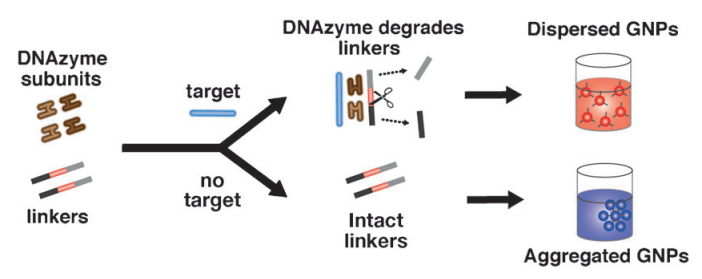Rapid point-of-care testing for multiple diseases from a drop of blood
March 5, 2013

DNAzyme catalyst combined with gold nanoparticles (GNPs) provides a simple, sensitive colorimetric parallel assay for various infectious diseases (credit: Kyryl Zagorovsky and Warren C. W. Chan/Angewandte Chemie)
A diagnostic system using DNA powder and gold nanoparticles being developed by scientists at the University of Toronto’s Institute of Biomaterials and Biomedical Engineering could provide rapid point-of-care diagnosis of the world’s leading infectious diseases in the near future.
BBME PhD student Kyryl Zagorovsky has developed a rapid diagnostic biosensor that will allow technicians to test for multiple diseases at the same time with one small sample, and with high accuracy and sensitivity. The biosensor relies upon gold nanoparticles, which change color.
Quantitative PCR (qPCR) is the method of choice, because it includes an enzymatic signal amplification step to achieve highly sensitive and specific detection of genetic targets, the scientists say in Angewandte Chemie. However, qPCR requires expensive equipment and highly trained personnel, limiting the use of this technique to medical laboratories. There is a strong need to develop cheaper and simpler DNA detection methods
Currently, scientists can target the particular disease they are searching for by linking gold particles with DNA strands: when a sample containing the disease gene (such as Malaria) is present, it clumps the gold nanoparticles, turning the sample blue. However, this method uses fluorescence as the readout, which is not an optimal detection method for POC applications because it requires access to a fairly complex fluorometer.
Rather than clumping the particles together, Zagorovsky immerses the gold nanoparticles in a DNA-based enzyme solution (DNAzyme — a synthetic DNA enzyme that can catalyze the cleavage or “snip” of another nucleic acid molecule). When a disease gene is introduced, the DNA is snipped from the gold nanoarticles, turning the sample red.
The advantage is that far less of the gene needs to be present for the solution to show noticeable color changes, amplifying detection. A single DNAzyme can clip up to 600 “links” between the target genes.
Just a single drop from a biological sample such as saliva or blood can potentially be tested in parallel, so that multiple diseases can be tested for in one sitting.
But the team has also demonstrated that they are able to transform the testing solution into a powder, making it light and far easier to ship than solutions, which degrade over time.
Powder can be stored for years at a time, and offers hope that the technology can be developed into efficient, cheap, over-the-counter tests for diseases such as HIV and malaria for developing countries, where access to portable diagnostics is a necessity.
This was applied experimentally to rapidly detect gonorrhea, syphilis, malaria, and hepatitis B infections.